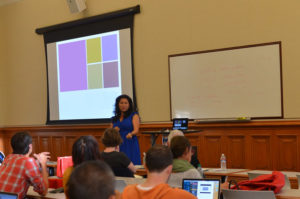9.10: En contexto- Ser y Estar I
- Page ID
- 114038
\( \newcommand{\vecs}[1]{\overset { \scriptstyle \rightharpoonup} {\mathbf{#1}} } \) \( \newcommand{\vecd}[1]{\overset{-\!-\!\rightharpoonup}{\vphantom{a}\smash {#1}}} \)\(\newcommand{\id}{\mathrm{id}}\) \( \newcommand{\Span}{\mathrm{span}}\) \( \newcommand{\kernel}{\mathrm{null}\,}\) \( \newcommand{\range}{\mathrm{range}\,}\) \( \newcommand{\RealPart}{\mathrm{Re}}\) \( \newcommand{\ImaginaryPart}{\mathrm{Im}}\) \( \newcommand{\Argument}{\mathrm{Arg}}\) \( \newcommand{\norm}[1]{\| #1 \|}\) \( \newcommand{\inner}[2]{\langle #1, #2 \rangle}\) \( \newcommand{\Span}{\mathrm{span}}\) \(\newcommand{\id}{\mathrm{id}}\) \( \newcommand{\Span}{\mathrm{span}}\) \( \newcommand{\kernel}{\mathrm{null}\,}\) \( \newcommand{\range}{\mathrm{range}\,}\) \( \newcommand{\RealPart}{\mathrm{Re}}\) \( \newcommand{\ImaginaryPart}{\mathrm{Im}}\) \( \newcommand{\Argument}{\mathrm{Arg}}\) \( \newcommand{\norm}[1]{\| #1 \|}\) \( \newcommand{\inner}[2]{\langle #1, #2 \rangle}\) \( \newcommand{\Span}{\mathrm{span}}\)\(\newcommand{\AA}{\unicode[.8,0]{x212B}}\)
Objetivos
- Recognize different uses of ser and estar

Luz y Jesús toman la misma clase de estudios latinoamericanos y tienen que preparar una presentación oral. Vuelve a leer su conversación y contesta las preguntas de análisis después.
| Jesús: | Hola, Luz, ¿cómo estás? |
| Luz: | Regular. Estoy cansada porque mis compañeras son ruidosas y no puedo dormir bien. Y tú, ¿cómo estás? |
| Jesús: | Estoy bien, pero estoy un poco preocupado por nuestra presentación en la clase de Estudios Latinoamericanos. |
| Luz: | ¿No estamos listos? Es una presentación bastante breve. |
| Jesús: | La parte visual está terminada, pero la parte oral es más importante y necesitamos organizar eso. |
| Luz: | ¿Cómo quieres organizar la parte oral? ¿Comienzo yo o comienzas tú? |
| Jesús: | Yo voy a estar nervioso y tú eres muy buena en las presentaciones. Tú puedes comenzar con la introducción y yo puedo continuar con los datos de nuestra investigación. |
| Luz: | Sí, los números son más fáciles para ti y siempre estoy confundida por las estadísticas. ¿Cuándo quieres practicar la presentación? |
| Jesús: | ¿Podemos reunirnos mañana después de clase? |
| Luz: | Sí, es una hora conveniente. Muy bien, hasta luego. |
| Jesús: | Gracias, hasta entonces. |
Preguntas de análisis:
Actividad \(\PageIndex{A}\)
Text only version of questions
Preguntas de análisis:
- Compara las instancias de “estar” + adjetivo con las instancias de “ser” + adjetivo. ¿Cuál verbo usamos en español para describir las personalidades? ¿Cuál verbo usamos para describir la emoción que siente una persona? ¿Cuál verbo usamos para describir las características permanentes de las cosas? ¿Cuál verbo usamos para describir la condición de las cosas?
Contributors and Attributions
CC licensed content, Shared previously
- Speech. Provided by: Berkeley Center for New Media. Located at: https://www.flickr.com/photos/calnewmedia/. License: CC BY-SA: Attribution-ShareAlike
- Speech. Provided by: Berkeley Center for New Media. Located at: https://flic.kr/p/TDQJpo. License: CC BY-SA: Attribution-ShareAlike
- En contexto: Ser y Estar I. Authored by: SUNY Oneonta with Lumen Learning. Provided by: SUNY Oneonta. License: CC BY: Attribution


